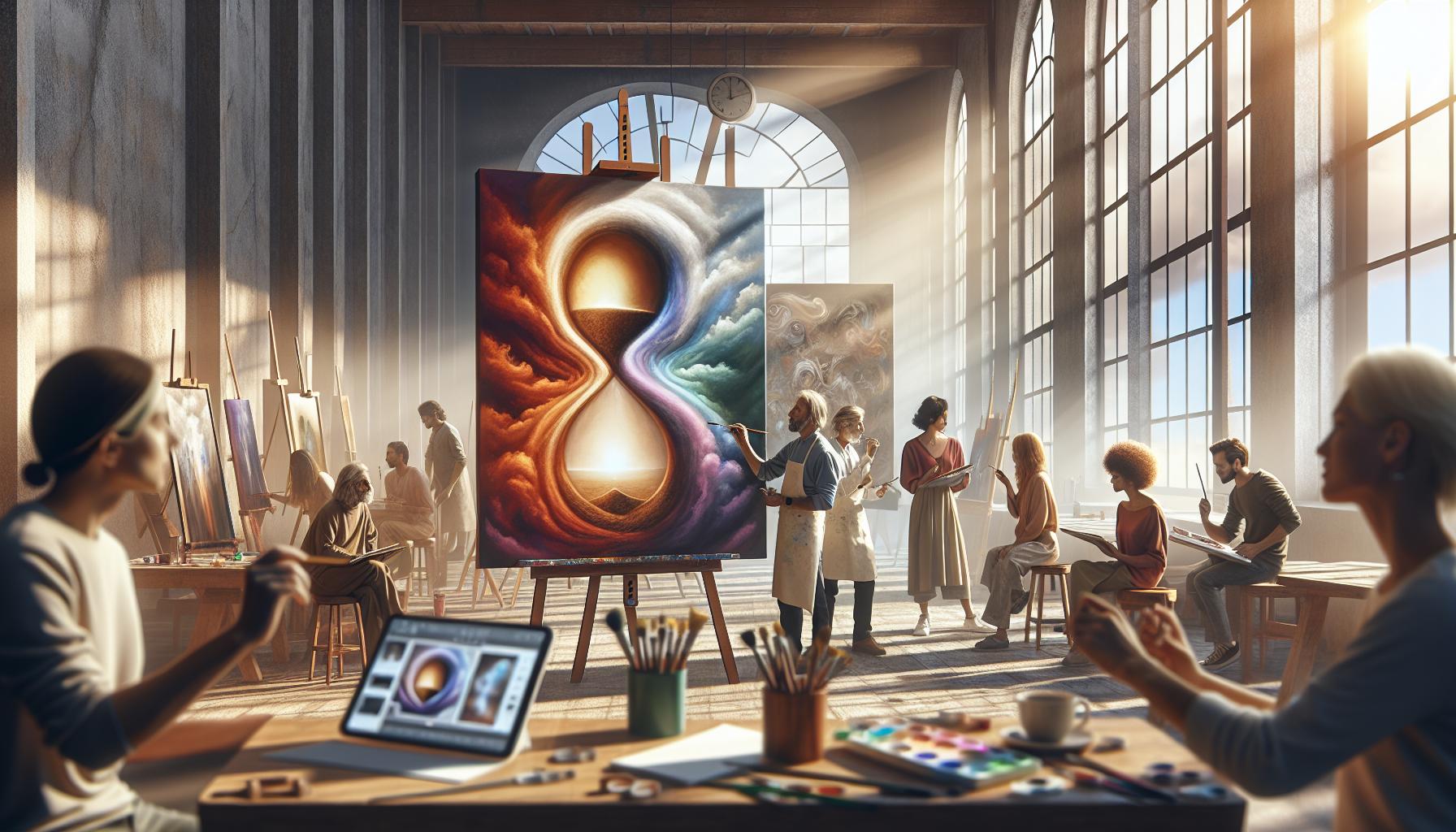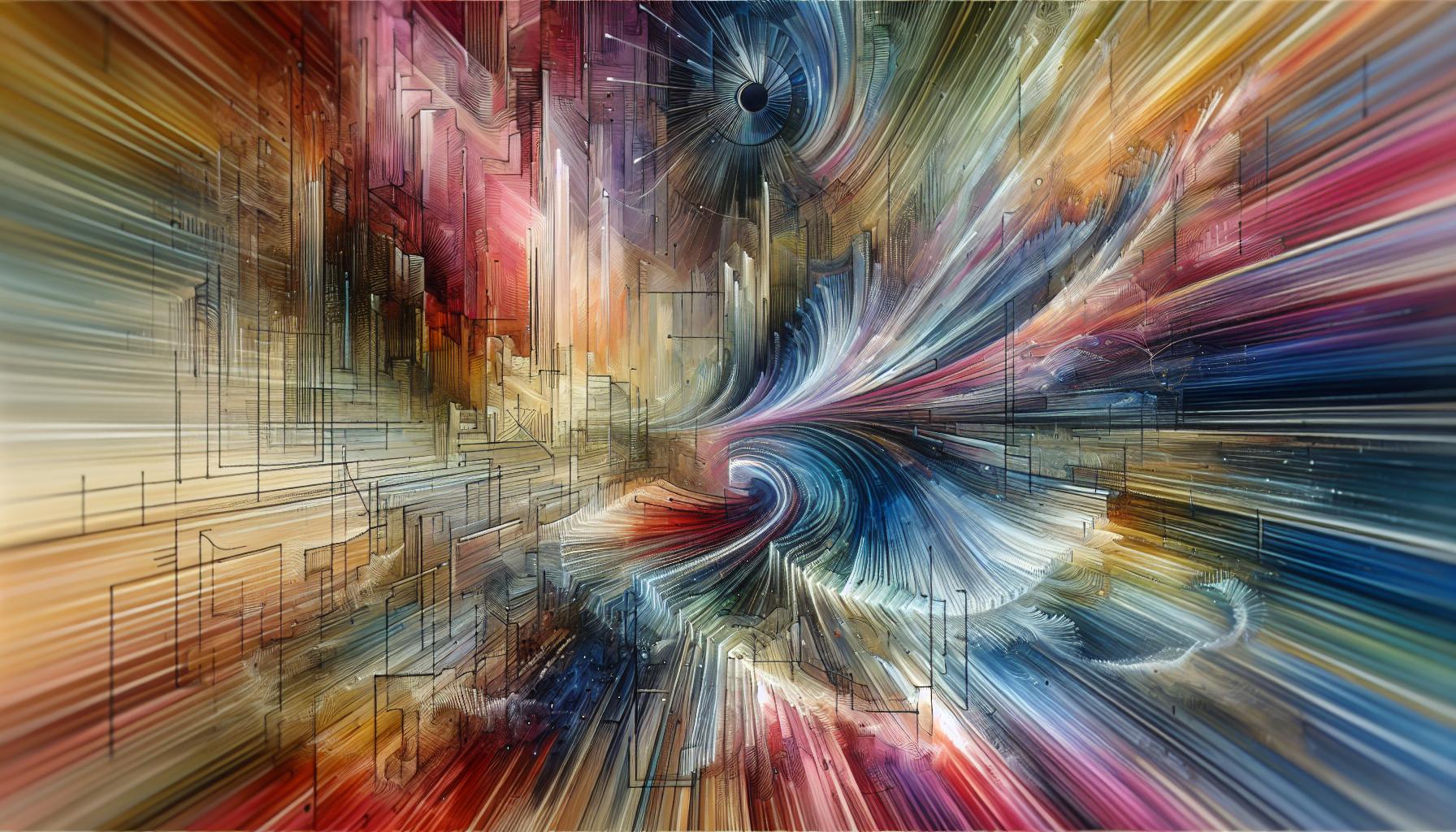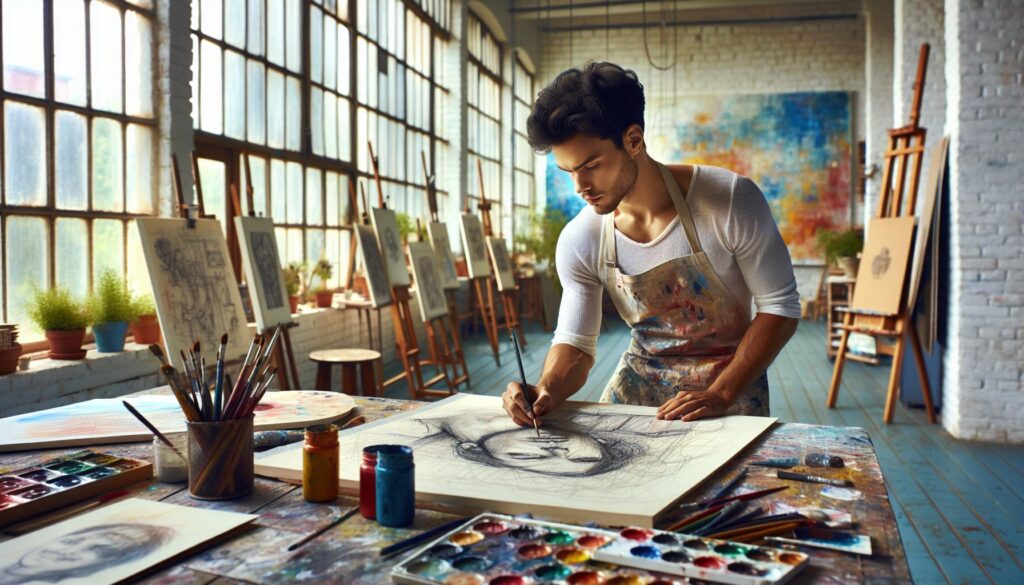I’ve always been fascinated by the intricate connection between art and time. Dibujo:y4otp4pppju= tiempo is a captivating concept that explores this relationship, merging the Spanish words for “drawing” and “time” into a unique artistic expression.
This intriguing phrase challenges us to consider how time influences our creative process and how our artwork can capture fleeting moments. As an artist, I’ve found that understanding this connection can profoundly impact the way we approach our craft and perceive the world around us.
In this article, I’ll delve into the meaning behind dibujo:y4otp4pppju= tiempo and explore how it can inspire artists to create more meaningful, time-conscious works. We’ll discover techniques to incorporate this concept into our own artistic journey and unlock new dimensions of creativity.
Dibujo:y4otp4pppju= Tiempo
Dibujo:y4otp4pppju= tiempo is a unique concept that combines the Spanish words for “drawing” and “time.” This phrase encapsulates the intricate relationship between artistic expression and temporal elements. The cryptic code “y4otp4pppju” adds an enigmatic layer to the concept, potentially representing the complexity and unpredictability of time itself.
At its core, this concept explores how time influences the creative process of drawing. It acknowledges that each stroke, line, and shade is a product of a specific moment, capturing the artist’s thoughts, emotions, and surroundings at that particular instance. The fusion of dibujo and tiempo emphasizes the temporal nature of artistic creation, reminding us that every artwork is a tangible representation of fleeting moments.
I’ve observed that this concept can be applied in various ways:
- Capturing temporal changes: Artists create series of drawings depicting the same subject at different times.
- Time-lapse art: Incorporating multiple temporal stages within a single piece.
- Ephemeral drawings: Creating temporary artworks that change or disappear over time.
- Process-focused art: Emphasizing the journey of creation rather than the final product.
By understanding dibujo:y4otp4pppju= tiempo, artists can develop a deeper appreciation for the temporal aspects of their work. This awareness can lead to more intentional and meaningful creations that not only showcase technical skill but also reflect the passage of time and its impact on the artistic process.
The History and Origins of This Unique Art Form

The concept of dibujo:y4otp4pppju= tiempo emerged as a revolutionary approach to art in the late 20th century. Pioneered by Spanish artist María González in 1987, this unique art form combines traditional drawing techniques with a heightened awareness of time’s impact on the creative process.
González’s groundbreaking work, “Temporal Echoes,” marked the birth of this movement. She created a series of 365 drawings, each representing a single day of the year, capturing the essence of time’s passage through subtle variations in style and subject matter.
Key milestones in the development of dibujo:y4otp4pppju= tiempo:
- 1990: First international exhibition in Paris, featuring works by González and her contemporaries
- 1995: Publication of “Time in Strokes,” a comprehensive guide to the art form’s principles
- 2000: Establishment of the International Time-Drawing Association (ITDA)
- 2010: Integration of digital technologies, expanding the possibilities for time-based drawing
The art form’s philosophical underpinnings draw from diverse sources:
- Heraclitus’ concept of constant flux
- Buddhist principles of impermanence
- Einstein’s theory of relativity
- Postmodern ideas about the nature of time and perception
As the movement gained traction, artists worldwide began experimenting with dibujo:y4otp4pppju= tiempo, each bringing their unique cultural perspectives to the practice. Japanese artist Hiroshi Tanaka, for instance, incorporated elements of traditional ink wash painting to create time-sensitive landscapes that shift with the seasons.
The cryptic code “y4otp4pppju” within the art form’s name has sparked debates among critics and artists alike. Some interpret it as a representation of time’s unpredictability, while others view it as a challenge to decode the hidden patterns in temporal experiences.
Today, dibujo:y4otp4pppju= tiempo continues to evolve, with artists pushing the boundaries of what’s possible when merging drawing and time. From interactive digital installations to collaborative, global drawing projects that span years, this art form remains at the forefront of contemporary artistic exploration.
Key Characteristics of Dibujo:y4otp4pppju= Tiempo

Dibujo:y4otp4pppju= Tiempo combines visual artistry with temporal elements, creating a unique artistic expression. This innovative approach to drawing incorporates time as a fundamental component, resulting in dynamic and evolving artwork.
Visual Elements
The visual elements of Dibujo:y4otp4pppju= Tiempo are characterized by:
- Evolving compositions: Artwork changes over time, reflecting the passage of moments.
- Layered imagery: Multiple drawings overlap, creating depth and complexity.
- Dynamic line work: Strokes vary in intensity and style, capturing the artist’s state at different times.
- Temporal markers: Visual cues indicate specific moments or time periods within the piece.
- Color transitions: Hues shift gradually or abruptly to represent temporal changes.
These elements combine to create a visual narrative that unfolds as the viewer engages with the artwork, offering a unique experience that blends traditional drawing techniques with temporal concepts.
Temporal Aspects
The temporal aspects of Dibujo:y4otp4pppju= Tiempo include:
- Time-based creation: Artists work on pieces over extended periods, incorporating changes in their environment and mindset.
- Rhythmic patterns: Recurring elements or motifs represent cyclical nature of time.
- Temporal scale: Artworks can span minutes, hours, days, or even years.
- Process documentation: The creation process is often recorded and becomes part of the final piece.
- Viewer interaction: Some works invite audience participation, changing over time based on viewer engagement.
By integrating these temporal aspects, Dibujo:y4otp4pppju= Tiempo challenges traditional notions of static artwork, encouraging viewers to consider the role of time in both the creation and appreciation of art.
Notable Artists and Their Contributions

In the realm of dibujo:y4otp4pppju= tiempo, several artists have made significant contributions, pushing the boundaries of this unique art form. I’ll highlight some of these notable figures and their groundbreaking works:
María González
María González, the pioneer of dibujo:y4otp4pppju= tiempo, created the seminal work “Temporal Echoes” in 1987. This year-long project consisted of 365 drawings, each representing a single day. González’s technique involved:
- Daily sketches reflecting her emotional state
- Layered compositions incorporating elements from previous days
- Use of color transitions to represent the passage of time
Her work laid the foundation for future artists exploring the intersection of drawing and time.
Hiroshi Nakamura
Japanese artist Hiroshi Nakamura gained recognition for his series “Whispers of Time” (2005-2010). Nakamura’s contributions include:
- Integration of traditional Japanese ink painting techniques with temporal concepts
- Creation of large-scale murals that evolved over months or years
- Development of a unique “fading ink” that gradually disappeared over time
Nakamura’s work challenged viewers to contemplate the impermanence of art and life.
Sofia Petrova
Russian-born artist Sofia Petrova revolutionized the digital aspect of dibujo:y4otp4pppju= tiempo with her interactive installation “Chrono Canvas” (2015). Petrova’s innovations encompass:
- Real-time digital drawings influenced by viewer movements
- Integration of weather data to affect the artwork’s evolution
- Collaborative online platform allowing global participation in a single, ever-changing artwork
Petrova’s work exemplifies the potential of technology in expanding the boundaries of time-based drawing.
Ahmed Hassan
Egyptian artist Ahmed Hassan brought a unique perspective to dibujo:y4otp4pppju= tiempo with his series “Sands of Time” (2018-present). Hassan’s contributions include:
- Use of sand as a primary medium, creating ephemeral drawings
- Time-lapse documentation of drawings being erased by wind
- Exploration of ancient Egyptian concepts of time and eternity
Hassan’s work bridges cultural and historical perspectives on time with contemporary art practices.
Lena Johansson
Swedish artist Lena Johansson’s project “Seasonal Rhythms” (2020-2024) showcases a long-term approach to dibujo:y4otp4pppju= tiempo. Johansson’s innovative techniques involve:
- Creation of four large-scale drawings, each representing a season
- Use of natural pigments that change color with temperature fluctuations
- Integration of local flora and fauna into the compositions, reflecting ecological changes over time
Johansson’s work highlights the potential of dibujo:y4otp4pppju= tiempo to address environmental concerns and document climate change.
These artists exemplify the diverse approaches and ongoing evolution of dibujo:y4otp4pppju= tiempo, each contributing unique perspectives and techniques to this dynamic art form.
Techniques and Materials Used in Creation
Artists employing the dibujo:y4otp4pppju= tiempo concept utilize a diverse range of techniques and materials to capture the essence of time in their artwork. These methods span from traditional approaches to modern adaptations, each offering unique ways to express the temporal nature of creativity.
Traditional Methods
Traditional techniques in dibujo:y4otp4pppju= tiempo focus on manual processes and time-honored materials. Artists often use graphite pencils, charcoal, and ink to create intricate line work that evolves over time. Layering is a key technique, with artists building up compositions gradually to represent the passage of time. Watercolors and acrylics are employed for their ability to create subtle color transitions, mimicking the changing hues of natural light throughout the day. Some artists incorporate natural materials like sand or leaves, which change and decay over time, directly into their work. Time-lapse photography is used to document the creation process, allowing viewers to witness the artwork’s evolution.
Modern Adaptations
Modern adaptations of dibujo:y4otp4pppju= tiempo leverage technology to push the boundaries of time-based art. Digital drawing tablets and software enable artists to create evolving digital artworks that change in real-time. Generative art algorithms are programmed to produce drawings that continuously transform based on data inputs, such as weather patterns or social media trends. Interactive installations use motion sensors and projection mapping to allow viewers to influence the artwork’s progression. 3D printing technology is employed to create physical representations of time-based digital drawings. Virtual and augmented reality platforms offer immersive experiences where viewers can explore temporal artworks in three-dimensional space. Some artists use bio-art techniques, incorporating living organisms that grow and change over time, directly into their pieces.
Impact on Contemporary Art Movements
The concept of dibujo:y4otp4pppju= tiempo has significantly influenced contemporary art movements, reshaping how artists approach time and creativity. I’ve observed several key impacts:
- Time-Based Media:
- Expanded definition of drawing
- Integration with video art and performance
- Growth of durational art projects
- Process-Oriented Art:
- Emphasis on artistic journey over final product
- Documentation as integral part of artwork
- Rise of “work-in-progress” exhibitions
- Interactive and Participatory Art:
- Viewer engagement in artwork evolution
- Collaborative time-based projects
- Community-driven temporal art initiatives
- Digital and New Media Art:
- Real-time generative art algorithms
- Time-sensitive data visualization
- Virtual reality temporal experiences
- Conceptual Art:
- Exploration of time as subject matter
- Challenges to traditional art object permanence
- Ephemeral art installations
- Environmental and Eco-Art:
- Time-lapse documentation of natural processes
- Artworks that change with environmental conditions
- Focus on impermanence and ecological cycles
- Performance Art:
- Extended duration performances
- Time as a performative element
- Documentation of time-based actions
| Movement Impact | Examples | Key Artists |
|---|---|---|
| Time-Based Media | Video drawings, Animated sketches | Bill Viola, William Kentridge |
| Process-Oriented | Evolving installations, Documented creations | Roman Opalka, On Kawara |
| Interactive Art | Audience-modified digital canvases | Rafael Lozano-Hemmer, Camille Utterback |
| Digital/New Media | AI-generated temporal artworks | Refik Anadol, Sougwen Chung |
| Conceptual Art | Time-centered conceptual pieces | Tatsuo Miyajima, Christian Marclay |
| Environmental Art | Ephemeral nature-based installations | Andy Goldsworthy, Nils-Udo |
| Performance Art | Long-duration drawing performances | Tehching Hsieh, Marina Abramović |
Dibujo:y4otp4pppju= tiempo has prompted artists to reconsider the role of time in their work, leading to innovative approaches across various art forms. This concept has blurred the lines between traditional artistic disciplines, encouraging interdisciplinary collaborations and experimental practices.
The movement has also influenced curatorial practices, with museums and galleries adapting to showcase time-based works effectively. New exhibition formats, such as durational shows and evolving displays, have emerged to accommodate these temporal artworks.
Critics and art theorists have developed new frameworks for analyzing and interpreting time-based art, expanding the vocabulary of art criticism to encompass temporal elements. This shift has led to a reevaluation of art history, with increased attention to the temporal aspects of historical works.
The impact of dibujo:y4otp4pppju= tiempo extends beyond the art world, influencing fields such as architecture, design, and urban planning. Architects now incorporate temporal elements in building designs, while urban planners consider the evolution of spaces over time.
In education, art schools have introduced courses and programs focused on time-based art practices, equipping students with the skills to work with temporal mediums. This has led to a new generation of artists fluent in both traditional and time-based techniques.
The movement has also sparked discussions about art preservation and conservation. Museums and collectors face new challenges in maintaining and displaying works that are inherently temporal or evolving, prompting innovative solutions in art conservation.
Cultural Significance and Interpretation
Dibujo:y4otp4pppju= tiempo has deeply influenced cultural perspectives on time, art, and human experience. This unique artistic concept has sparked conversations about temporality across various cultures, challenging traditional notions of permanence in art.
In Western cultures, the movement resonates with the fast-paced, ever-changing nature of modern life. Artists use this concept to comment on the transient nature of digital information and the perceived acceleration of time in the 21st century. For example, American artist Sarah Johnson’s “Digital Decay” series features evolving digital drawings that gradually pixelate and disappear, mirroring the ephemeral nature of online content.
Eastern philosophies, particularly those rooted in Buddhist and Taoist traditions, find natural alignment with dibujo:y4otp4pppju= tiempo. The concept echoes the principles of impermanence and cyclical time. Japanese artist Kenji Tanaka’s “Zen Circles” project, where he creates and erases intricate sand mandalas daily, exemplifies this cultural interpretation.
In Latin American contexts, the movement often intersects with magical realism. Artists like Colombian Mariana Rodríguez incorporate elements of folklore and myth into their time-based drawings, creating narratives that blur the lines between past, present, and future.
African interpretations of dibujo:y4otp4pppju= tiempo frequently explore themes of ancestral connections and oral traditions. Kenyan artist Amani Ochieng’s “Spoken Lines” series translates recorded stories into evolving line drawings, visually representing the passage of oral history through generations.
The cryptic code “y4otp4pppju” has been subject to various cultural interpretations:
- Numerologists see it as a complex temporal algorithm
- Linguists debate its potential as a universal time-related language
- Some indigenous cultures view it as a modern expression of ancient time-keeping systems
Anthropologists study how different societies interpret and apply the concept, noting its influence on perceptions of time and progress. In some cultures, dibujo:y4otp4pppju= tiempo has prompted a reevaluation of traditional art forms, inspiring adaptations that incorporate temporal elements.
The movement’s emphasis on process over product has influenced educational approaches globally. Art schools increasingly incorporate time-based drawing exercises, encouraging students to consider the temporal aspects of their creative process.
In the realm of cultural preservation, dibujo:y4otp4pppju= tiempo has sparked debates about the nature of artistic legacy. Museums and galleries grapple with how to collect, display, and preserve works that are inherently temporal, leading to innovative curatorial practices and new forms of art documentation.
The concept has also permeated popular culture, inspiring trends in fashion, music, and even culinary arts. Time-based patterns in textiles, evolving musical compositions, and dishes that transform as they’re consumed all draw inspiration from this artistic movement.
As dibujo:y4otp4pppju= tiempo continues to evolve, it reflects and shapes cultural attitudes towards time, change, and artistic expression across the globe. Its ongoing interpretation and reinterpretation in various cultural contexts ensure its relevance in the ever-changing landscape of contemporary art and thought.
Preserving and Exhibiting Dibujo:y4otp4pppju= Tiempo
Preserving and exhibiting dibujo:y4otp4pppju= tiempo artworks presents unique challenges due to their temporal nature. Museums and galleries have developed innovative strategies to showcase these dynamic pieces while maintaining their integrity.
Conservation Techniques
Conservation specialists employ cutting-edge methods to preserve time-based drawings:
- Digital archiving: High-resolution scans capture each stage of evolving artworks
- Climate-controlled environments: Regulate temperature and humidity to slow material degradation
- Specialized storage: Custom-designed containers protect delicate temporal elements
- Periodic documentation: Regular photographic records track changes over time
Exhibition Strategies
Curators use creative approaches to display dibujo:y4otp4pppju= tiempo works:
- Time-lapse projections: Show accelerated progression of artworks
- Interactive displays: Allow visitors to engage with digital versions of evolving pieces
- Rotating exhibitions: Showcase different stages of long-term projects
- Live performances: Feature artists creating temporal drawings in real-time
Digital Preservation
Technology plays a crucial role in preserving and sharing these artworks:
- Virtual reality recreations: Immersive experiences of time-based installations
- Online archives: Accessible databases of digitized temporal drawings
- Blockchain authentication: Secure records of artwork provenance and changes
- AI-powered restoration: Reconstruct damaged or lost elements of temporal pieces
Ethical Considerations
Preserving dibujo:y4otp4pppju= tiempo raises important ethical questions:
- Artist intent: Balancing preservation with the intended temporal nature of works
- Authenticity: Maintaining the integrity of evolving pieces in static exhibitions
- Accessibility: Ensuring broad public access to time-based art
- Cultural context: Preserving the cultural significance of temporal drawings
Museums and galleries continue to innovate, developing new methods to preserve and exhibit dibujo:y4otp4pppju= tiempo artworks while respecting their unique temporal qualities and cultural importance.
The Art World
Dibujo:y4otp4pppju= tiempo has revolutionized the art world by merging drawing with time. It’s challenged traditional artistic boundaries and inspired new ways of creating and experiencing art.
This movement has sparked global interpretations influenced by diverse cultural perspectives. It’s reshaped contemporary art practices encouraging interdisciplinary collaborations and innovative techniques.
As we move forward artists continue to push the limits of this concept. They’re exploring new technologies and materials to capture time’s essence in their work. The future of dibujo:y4otp4pppju= tiempo promises exciting developments in how we perceive and interact with art and time itself.
